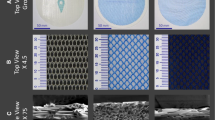Abstract
Introduction
Laparoscopic ventral hernia repair uses tacks to secure mesh. The mesh is designed to maximize tissue ingrowth while minimizing adhesions. We hypothesized: (1) a collagen-coated polyester mesh (PCO) will form fewer adhesions than an ePTFE-polypropylene composite (BC) and (2) absorbable tacks are equivalent to metal tacks.
Methods
In a porcine model of adhesion formation, three pieces of 10×15-cm mesh were placed on the anterior abdominal wall. PCO was secured with absorbable (PLA) or metal tacks (PT), BC with PT. At 28 days, adhesion formation, abdominal-wall adherence, and tissue ingrowth were analyzed.
Results
PCO induced fewer adhesions (14.5% vs 53.4%, P=0.007). On an adhesion scale (0–5), BC scored 3.6 vs 1.75 for PCO (P<0.03). There was no difference in adhesion strength, tack adhesions, or abdominal-wall peel force. Histology showed equal ingrowth.
Conclusions
PCO induces fewer adhesions than BC. There is no difference in the ingrowth of the two mesh types. The PLA achieves equivalent mesh incorporation to the PT.







Similar content being viewed by others
References
Santora TA, Roslyn JJ (1993) Incisional hernia. Surg Clin North Am 73:557–570
Heniford BT, Park A, Ramshaw BJ, Voeller G (2003) Laparoscopic repair of ventral hernias: nine years’ experience with 850 consecutive hernias. Ann Surg 238:391–399
Hesselink VJ, Luijendijk RW, de Wilt JH, Heide R, Jeekel J (1993) An evaluation of risk factors in incisional hernia recurrence. Surg Gynecol Obstet 176:228–234
Luijendijk RW, Hop WC, van den Tol MP, de Lange DC, Braaksma MM, IJzermans JN, Boelhouwern RU, de Vries BC, Salu MK, Wereldsma JC, Bruijninckx CM, Jeekel J (2000) A comparison of suture repair with mesh repair for incisional hernia. N Engl J Med 343:392–398
DeMaria EJ, Moss JM, Sugerman HJ (2000) Laparoscopic intraperitoneal polytetrafluoroethylene (PTFE) prosthetic patch repair of ventral hernia. Prospective comparison to open prefascial polypropylene mesh repair. Surg Endosc 14:326–329
Ramshaw BJ, Esartia P, Schwab J, Mason EM, Wilson RA, Duncan TD, Miller J, Lucas GW, Promes J (1999) Comparison of laparoscopic and open ventral herniorrhaphy. Am Surg 65:827–831
Carbajo MA, Martin del Olmo JC, Blanco JI, de la Cuesta C, Toledano M, Martin F, Vaquero C, Inglada L (1999) Laparoscopic treatment vs open surgery in the solution of major incisional and abdominal wall hernias with mesh. Surg Endosc 13:250–252
McGreevy JM, Goodney PP, Birkmeyer CM, Finlayson SR, Laycock W, Birkmeyer JD (2003) A prospective study comparing the complication rates between laparoscopic and open ventral hernia repairs. Surg Endosc 17:1778–1780
Carbajo MA, Martp del Olmo J, Blanco J, Toledano M, de la Cuesta C, Ferreras C, Vaquero C (2003) Laparoscopic approach to incisional hernia. Surg Endosc 17:118–122
Heniford BT, Park A, Ramshaw BJ, Voeller G (2000) Laparoscopic ventral and incisional hernia repair in 407 patients. J Am Coll Surg 190:645–650
Borrazzo EC, Belmont MF, Boffa D, Fowler DL (2004) Effect of prosthetic material on adhesion formation after laparoscopic ventral hernia repair in a porcine model. Hernia 8:108–112
Garrard CL, Clements RH, Nanney L, Davidson JM, Richards WO (1999) Adhesion formation is reduced after laparoscopic surgery. Surg Endosc 13:10–13
Harris ES, Morgan RF, Rodeheaver GT (1995) Analysis of the kinetics of peritoneal adhesion formation in the rat and evaluation of potential antiadhesive agents. Surgery 117:663–669
Matthews BD, Pratt BL, Pollinger HS, Backus CL, Kercher KW, Sing RF, Heniford BT (2003) Assessment of adhesion formation to intra-abdominal polypropylene mesh and polytetrafluoroethylene mesh. J Surg Res 114:126–132
van ‘t Riet M, de Vos van Steenwijk PJ, Bonthuis F, Marquet RL, Steyerberg EW, Jeekel, J, Bonjer HJ (2003) Prevention of adhesion to prosthetic mesh: comparison of different barriers using an incisional hernia model. Ann Surg 237:123–128
Bellon JM, Jurado F, Garcia-Moreno F, Corrales C, Carrera-San Martin A, Bujan J (2002) Healing process induced by three composite prostheses in the repair of abdominal wall defects. J Biomed Mater Res 63:182–190
Bellon JM, Garcia-Honduvilla N, Jurado F, Garcia-Carranza A, Garcia-Moreno F, Martin AC, Bujan J (2001) Use of composite prostheses in the repair of defects in the abdominal wall: prosthetic behaviour at the peritoneum. Eur J Surg 167:666–671
Bellon JM, Garcia-Carranza A, Jurado F, Garcia-Honduvilla N, Carrera-San Martin A, Bujan J (2001) Peritoneal regeneration after implant of a composite prosthesis in the abdominal wall. World J Surg 25:147–152
Moreno-Egea A, Liron R, Girela E, Aguayo JL (2001) Laparoscopic repair of ventral and incisional hernias using a new composite mesh (Parietex): initial experience. Surg Laparosc Endosc Percutan Tech 11:103–106
Aube C, Pessaux P, Tuech JJ, Du Plessis R, Becker P, Caron C, Arnaud JP (2004) Detection of peritoneal adhesions using ultrasound examination for the evaluation of an innovative intraperitoneal mesh. Surg Endosc 18:131–135
Eid GM, Prince JM, Mattar SG, Hamad G, Ikrammudin S, Schauer PR (2003) Medium-term follow-up confirms the safety and durability of laparoscopic ventral hernia repair with PTFE. Surgery 134:599–603
Carbonell AM, Harold KL, Mahmutovic AJ, Hassan R, Matthews BD, Kercher KW, Sing RF, Heniford BT (2003) Local injection for the treatment of suture site pain after laparoscopic ventral hernia repair. Am Surg 69:688–691
Birch DW, Park A (2001) Octylcyanoacrylate tissue adhesive as an alternative to mechanical fixation of expanded polytetrafluoroethylene prosthesis. Am Surg 67:974–978
van’t Riet M, de Vos van Steenwijk PJ, Kleinrensink GJ, Steyerberg EW, Bonjer HJ (2002) Tensile strength of mesh fixation methods in laparoscopic incisional hernia repair. Surg Endosc 16:1713–1716
Acknowledgements
This study is funded via a grant from Sofradim Corporation, Trévoux, France.
Author information
Authors and Affiliations
Corresponding author
Additional information
This work was presented at the meeting of the American Hernia Society, Orlando, Fla. USA, in February 2004
Rights and permissions
About this article
Cite this article
Duffy, A.J., Hogle, N.J., LaPerle, K.M. et al. Comparison of two composite meshes using two fixation devices in a porcine laparoscopic ventral hernia repair model. Hernia 8, 358–364 (2004). https://doi.org/10.1007/s10029-004-0258-x
Received:
Accepted:
Published:
Issue Date:
DOI: https://doi.org/10.1007/s10029-004-0258-x




